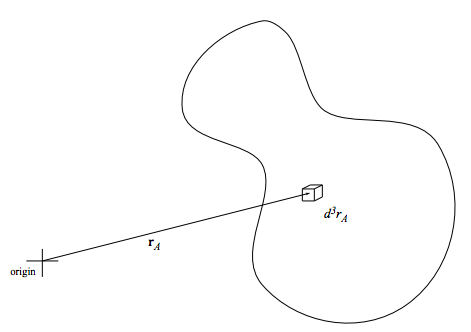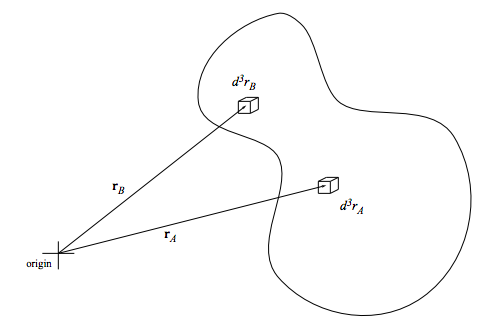8.4: Distribution Functions
( \newcommand{\kernel}{\mathrm{null}\,}\)
8.4.1 One-particle distribution functions
What is the mean number of particles in the box of volume d3rA about rA?

The probability that particle 1 is in d3rA about rA is
d3rA∫d3r2∫d3r3⋯∫d3rN∫d3p1⋯∫d3pNe−βH(rA,r2,r3,…,rN,p1,…,pN)∫d3r1∫d3r2∫d3r3⋯∫d3rN∫d3p1⋯∫d3pNe−βH(r1,r2,r3,…,rN,p1,…,pN).
The probability that particle 2 is in d3rA about rA is
∫d3r1d3rA∫d3r3⋯∫d3rN∫d3p1⋯∫d3pNe−βH(r1,rA,r3,…,rN,p1,…,pN)∫d3r1∫d3r2∫d3r3⋯∫d3rN∫d3p1⋯∫d3pNe−βH(r1,r2,r3,…,rN,p1,…,pN).
And so forth. I could write down N different integrals, but all of them would be equal.
Thus the mean number of particles in d3rA about rA is
π1(rA)d3TA
=Nd3rA∫d3r2∫d3r3⋯∫d3rN∫d3p1⋯∫d3pNe−βH(rA,r2,r3,…,rN,p1,…,pN)∫d3r1∫d3r2∫d3r3⋯∫d3rN∫d3p1⋯∫d3pNe−βH(r1,r2,r3,…,rN,p1,…,pN)
=Nd3rA∫d3r2∫d3r3⋯∫d3rN∫d3p1⋯∫d3pNe−βH(rA,r2,r3,…,rN,p1,…,pN)h3NN!Z(T,V,N)
=1(N−1)!d3rA∫d3r2∫d3r3⋯∫d3rNe−βU(rA,r2,r3,…,rN)Q(T,V,N)
8.4.2 Two-particle distribution functions
What is the mean number of pairs of particles, such that one member of the pair in a box of volume d3rA about rA and the other member is in a box of volume d3rB about rB?

The probability that particle 1 is in d3rA about rA and particle 2 is in d3rB about rB is
d3rA∫d3r1∫d3r2∫d3r3⋯∫d3rN∫d3p1⋯∫d3pNe−βH(rA,rB,r3,…,rN,p1,…,pN).
The probability that particle 2 is in d3rA about rA and particle 1 is in d3rB about rB is
d3rBd3rA∫d3r3⋯∫d3rN∫d3p1⋯∫d3pNe−βH(rB,rA,r3,…,rN,p1,…,pN)∫d3r1∫d3r2∫d3r3⋯∫d3rN∫d3p1⋯∫d3pNe−βH(r1,r2,r3,…,rN,p1,…,pN).
The probability that particle 3 is in 3rA about rA and particle 1 is in d3rB about rB is
d3rB∫d3r2d3rA⋯∫d3rN∫d3p1⋯∫d3pNe−βH(rB,r2,rA,…,rN,p1,…,pN)∫d3r1∫d3r2∫d3r3⋯∫d3rN∫d3p1⋯∫d3pNe−βH(r1,r2,r3,…,rN,p1,…,pN).
And so forth. I could write down N(N − 1) different integrals, but all of them would be equal.
Thus the mean number of pairs with one particle in d3rA about rA and the other in d3rB about rB is
n2(rA,rB)d3rAd3rB
=N(N−1)d3rAd3rB∫d3r3⋯∫d3rN∫d3p1⋯∫d3pNe−βH(rA,rB,r3,…,rN,p1,…,pN)∫d3r1∫d3r2∫d3r3⋯∫d3rN∫d3p1⋯∫d3pNe−βH(r1,r2,r3,…,rN,p1,…,pN)
=1(N−2)!d3rAd3rB∫d3r3⋯∫d3rNe−βU(rA,rB,r3,…,rN)Q(T,V,N).
Problems
8.7 Correlations of nearby particles
Suppose that (as is usual) at small distances the interatomic potential u(r) is highly repulsive. Argue that at small r,
g2(r)≈ constant e−u(r)/kBT.
Do not write down a long or elaborate derivation. . . I’m looking for a simple qualitative argument.
8.8 Correlations between non-interacting identical quantal particles
Guess the form of the pair correlation function g2(r) for ideal (non-interacting) fermions and bosons. Sketch your conjectures, and then compare them to the graphs presented by G. Baym in Lectures on Quantum Mechanics (W.A. Benjamin, Inc., Reading, Mass., 1969) pages 428 and 431.
8.9 Correlation functions and structure factors
A typical isotropic fluid, at temperatures above the critical temperature, has correlation functions that are complicated at short distances, but that fall off exponentially at long distances. In fact, the long-distance behavior is
g2(r)=1+Ae−r/ξr
where ξ, the so-called correlation length, depends on temperature and density. In contrast, at the critical temperature the correlation function falls off much more slowly, as
g2(r)=1+Ar1+η
Find the structure factor
S(k)=∫d3r[g2(r)−1]e−ik⋅r
associated with each of these correlation functions. Will your results match those of experiments at small values of k or at large values (i.e. at long or short wavelengths)?
8.10 Long wavelength structure factor
Show that, for an isotropic fluid, dS(k)dk vanishes at k = 0. Here S(k) is the structure factor
S(k)=1+ρ∫d3r[g2(r)−1]eik⋅r.
8.11 Correlations in a magnetic system
In the Ising model for a magnet, described in problem 4.9, the (net) correlation function is defined by
Gi≡⟨s0si⟩−⟨s0⟩2,
where the site j = 0 is some arbitrary “central spin”. Using the results of problem 4.9, show that for a lattice of N sites,
χT(T,H)=Nm2kBT∑iGi.


